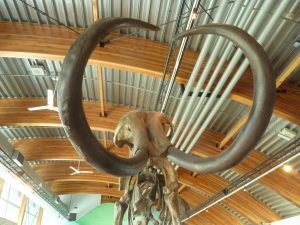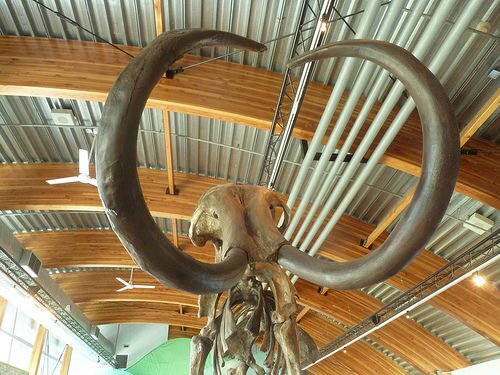
PENN STATE, UNIVERSITY PARK, Pa.—While the Minoan culture on Crete was just beginning, woolly mammoths were disappearing from St. Paul Island, Alaska, according to an international team of scientists who have dated this extinction to 5,600 years ago.
“It’s amazing that everything turned out so precisely with dating of extinction at 5,600 plus or minus 100 years,” said Russell Graham, professor of geosciences, Penn State.”
St. Paul Island lies about 400 miles north of the Aleutian Islands and was part of the Bering Land Bridge before sea level rose when the last glacial period ended. Previous researchers radiocarbon-dated remains of five mammoths to about 6,480 years ago, but there was no way to know if these were the last five animals.
The researchers used a variety of proxies to date the demise of the mammoths on the island. Proxies are things in the environment that can be used to independently document the presence of an organism, even though they are not parts of it. In this study, three different spores from fungi that grow on large animal dung were extracted from lake cores and used to determine when the mammoths were no longer on the island. Proxies in sediments from cores from a lake near the cave were used to determine the time of the demise of the mammoth population.
“We see a reduction in the three species of fungus, all of which are associated with the dung of large animals,” said Graham. “These spores are a marker for the presence of large animals like mammoths.”
Beside the mammoths, the only animals appearing on the island in “prehistoric” times were arctic foxes, shrews and polar bears, and there is no evidence of polar bears before 4,000 years ago. Humans did not arrive on the island until 1787 C.E. The only large mammals present were mammoths.
Sediment DNA from the lake cores showed the presence of mammoth DNA until 5,650 years ago, plus or minus 80 years. After that time, there is no mammoth DNA and so no mammoths on the island. The youngest of the newly dated mammoth remains’ dates fall within the mammoth DNA range and the fungal spore dates as well.
Using state-of-the-art methods for radiocarbon dating, the researchers used 14 newly recovered remains from various areas on the island to help document the time of extinction.
“The St. Paul mammoth demise is now one of the best-dated prehistoric extinctions, ” the researchers report today (August 1) in the Proceedings of the National Academy of Sciences.
The researchers also used environmental proxies to investigate habitat changes at the time of extinction. The island, which formed between 14,700 and 13,500 years ago rapidly shrank until 9,000 years ago and continued slowly shrinking until 6,000 years ago and now is only 42 square miles in area. While large animals like mammoths became extinct on the continents about 12,000 years ago due to climate change and habitat restructuring, the process was different on the island.
The shrinking of the island concentrated the mammoths in a smaller area and diminished available water. Pollen from the lake cores indicate that the area around the lake was denuded of vegetation by the mammoths. Like elephants today, when the water became cloudy and turgid, the mammoths probably dug holes nearby to obtain cleaner water. Both of these things increased erosion in the area and helped fill in the lake, decreasing the available water even more.
After the extinction of the mammoths, the cores show that erosion stopped and vegetation returned to the area. In essence, the mammoths contributed to their own demise.
The researchers note that this research “highlights freshwater limitation as an overlooked extinction driver and underscores the vulnerability of small island populations to environmental change, even in the absence of human influence,”
Source: Penn State University news release.
_________________________________________________
Reconstructed mammoth. Matt Boulton, Wikimedia Commons
_____________________________________________________
Also working on this project from Penn State were Soumaya Belmecheri, former postdoctoral fellow now at the Laboratory of Tree Ring Research, University of Arizona; Brendan J. Culleton, research associate in anthropology; and Lee Newsom, associate professor of anthropology.
The team also consisted of Kyungcheol Choy, Ruth Rawcliffe, and Émilie Saulnier-Talbot, Alaska Stable Isotope Center; and Matthew J. Wooller, Alaska Stable Isotope Center and School of Fisheries and Ocean Science, University of Alaska, Fairbanks; Lauren J. Davies, Duane Froese, University of Alberta; Peter D. Heintzman, Beth Shapiro and Joshua D. Kapp, University of California, Santa Cruz; Carrie Hritz, AAAS Science and Technology Policy Fellow; and Yue Wang and John W. Williams, University of Wisconsin, Madison.
The National Science Foundation supported this work.
________________________________________________________________

______________________________________________
Travel and learn with Far Horizons.
____________________________________________
This richly illustrated issue includes the following stories: Recent findings shedding new light on the whereabouts of the remains of Philip of Macedon, father of Alexander the Great; how an archaeologist-sculptor is bringing bones of the dead back to life; archaeologists uncovering town life at the dawn of civilization; an exclusive interview with internationally acclaimed archaeologist James M. Adovasio about what makes the Meadowcroft Rockshelter prominent in the ongoing search for the first Americans; what archaeologists are finding at the site of the ancient city of Gath, the home town of the biblical Philistine giant, Goliath; and how scientists are redrawing the picture of human evolution in Europe. Find it on Amazon.com.







